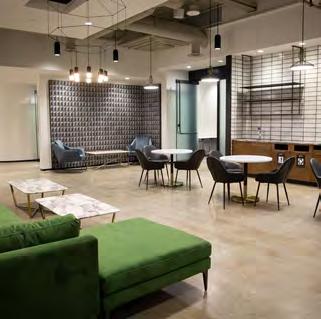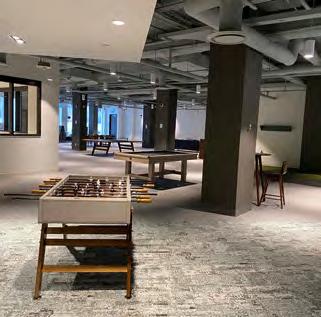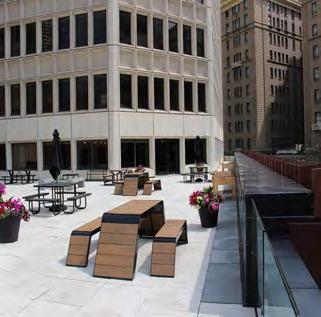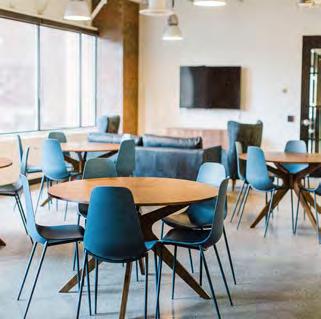
8 minute read
Calgary Office Space In-transition
STABILITY WILL TAKE ABOUT TWO YEARS
BY JOHN HARDY
Advertisement
For most Calgary area commercial real estate professionals, the 2021-2022 Calgary market is much like doing business in an unpredictable unknown. There are many past and present business factors which have impacted Calgary’s commercial real estate.
While the nearly one-and-a-half years of workplace lockdowns – forcing employees to work virtual from home – have been a crushing tsunami, taking a huge toll on Calgary’s commercial space, not all of Calgary’s commercial real estate crunch is COVID-related.
Calgary is also more than six years into a severe commodity price-induced downturn which has significantly affected Calgary business, the economy, migration, employment, consumer confidence and the demand for commercial real estate.
“To best understand the scope of the situation,” says Matt Rachiele, the plugged-in senior vice president of Investment Sales with Colliers, “the city-wide Calgary office market consists of approximately 73 million square feet (sf) of space. Currently, there is a more than a 28 per cent vacancy rate of about 20 million sf. Downtown has, by far, the highest vacancy rate of any submarket in Calgary and saw the largest change during 2020.”
As the charts and graphs show, all areas of the city were broadsided by office vacancy increases during the past year. Again, while the workplace impact of the pandemic has battered office space needs and commercial real estate, there continue to be other factors in-play. “Of course, the lockdowns have limited people from going to work and interacting with local social gatherings,” explains Todd Throndson, principal and managing director with Calgary’s Avison Young Commercial Real Estate Services. “Companies have largely allowed their staff to work from home during the pandemic and those changes resulted in challenges for communication, team building and accountability.
“The lack of staff being in the office, combined with other pandemic restrictions, have also had an effect the amenities that could still be offered, which caused service tenants (particularly retail) to struggle just to meet their obligations.


Employers are reassessing space requirements and reviewing their return-to-office transition strategies, which may translate to reconfigurations and, in some cases, space reductions.”
He uses reams of charts and stats to compare Q1 2019 numbers with Q1 2021 re-opening-from-COVID numbers. In 2019, overall downtown vacancy was 25.3 per cent. This year it’s 28.9 per cent. Class A was 27.2 and today it’s 33. Class B was 33.8. Now it’s 37.9.
“Class A office space, which historically housed many of Calgary’s Oil & Gas companies, has been the hardest hit between 2019 and 2021 – an over 14 per cent increase in vacancy,” Rachiele says. “The top 10 tenants downtown Calgary (all energy names) amount to a total of about eight million square feet, with six of 10 looking to meaningfully reduce their space requirements at lease expiry, mostly due to internal reorganizations and M&A activity.
“Sadly, consolidation in the oil patch is likely to continue in the years ahead. We will see idle talent and resources falling out of that and ‘re-tooled’ and deployed on emerging industries, most notably sectors like alternative energy and technology.”
Throndson suggests that large-scale merger and acquisition activity (which started in 2020) will also continue and likely contribute to even higher vacancy. “Calgary’s vacancy rate could be upwards of 30 per cent by the end of this year. And tenants are smaller than they used to be. The majority of deals completed today are under 10,000 sf.”
He cites three significant Calgary commercial real estate trends. “The interest in the central core from suburban tenants, looking to take advantage of the large selection in availabilities and the corresponding downward pressure on rental rates in the downtown core. Also, the reassessment of space requirements with employers reviewing their return to office transition strategies may translate to reconfigurations and, in some cases, space reductions. And the trend of early renewals, where tenants look to reduce their rental costs through an early renewal process, by giving the landlord more term on the lease. “This has been a big part of the pandemic as the tenant gets reduced cost exposure and the landlord gets more certainty through term extension.”
Whatever the reasons, and with Calgary’s Class A downtown office space creeping-up on 30 per cent vacancy, Calgary commercial real estate seems ready to pivot and deal with the glut.
Aside from lease terms and vacancy rates, Throndson emphasizes that “The downtown market is one of Calgary’s largest tax generators and the City is looking at ways to invest in this area to help it grow and attract business. Although it’s still early on the path to addressing the unprecedented vacancy in our city’s office market, the newly approved Greater Downtown Plan is a great starting point.”
Matt Rachiele agrees. “The City’s plan contemplates an initial $200 million investment in downtown vibrancy and implementation. The ultimate goal is $1 billion of investment over the next 10 years, to revitalize the core and retire six million sf of buildings (14 per cent of downtown space) from inventory through conversion or adaptive reuse – residential, student or seniors housing, post-secondary institutions and/or amenities.”
Allowing for the office space projections and calculables, Calgary’s commercial real estate experts and business insiders are grappling with the unpredictable unknowns: people and the new workplace normals.
When the first lockdowns were announced, the proverbial last person to leave the office turned off the lights, leaving most of Calgary’s busy office spaces dark and gapingly empty.
Many office workers abruptly, awkwardly or easily adjusted. They huddled with Wi-Fi on-the-fly, at the kitchen counter, the dining room table or a makeshift home workspaces wherever they could create one. Many suddenly embraced often jarring Zoom-immersion into their workdays and, by and large, they managed. Instead of the usually office buzz, they worked around speedbumps and distractions like dogs barking, kids playing, doorbells ringing, anytime snacking from the fridge and 24/7 slouching around in leisure wear.
Whether for efficiency, productivity, personal interactions and face-to-face communication and other basics of working in offices, the lights are being turned back on, t-shirts, track pants and hoodies are back in the closet and company coffee machines are being cranked up. Calgary offices are readying for the changes and some drastic new normals.
“Recent surveys indicate that employees have a desire to return to the workplace,” Throndson says. “Employers and employees are showing frustration and mental fatigue from working from home. The amount of time they want to spend working from home is shrinking and they feel it’s more difficult to establish and maintain relationships with colleagues while working from home.
“While there are new and viable alternate vehicles for communication and collaboration, people still crave direct contact. That’s proven and undisputed. While the future of the workplace is definitely evolving, we believe there remains a definite need for office environments.”
He notes that commercial leasing clients are placing more emphasis and scrutiny on building technology. “Those products or features previously considered luxuries (such as an app on your phone to call an elevator) are now being considered by landlords as a means to give tenants more optionality with their staff. There is also growing interest in healthy buildings – improved ventilation, air quality, lighting and thermal health. We anticipate technology and health will be big drivers for upgrades to buildings.” Commercial real estate professionals agree that the various new normals will make for a significantly challenged market.
He points out that Calgary landlords are continuing to look everywhere for new tenants and are very aggressive with rental incentives and inducements for tenants. From experience he adds that, in the roller coaster business of Calgary commercial real estate, “Landlords are starting to show a more conservative side and are trending towards less risk tolerance. Like a much more cautious and careful assessment of tenants’ historical performance and ability to pay rent in determining what they will offer to complete a deal.”
According to CBRE’s 2021 Workplace Strategy Reset Report, remote work is here to stay, but so too is the office.
The Report notes that a mass shift to remote working during the pandemic has put a spotlight on a trend that has been growing but is not new: fluidity in work styles. Most employees want to work in a more balanced way and as they return to the office, they will desire flexibility and choice. CBRE cautions that employers seeking to come out ahead in the race for talent, will need to build trust and offer choice.”
The physical office will remain a key part of the new hybrid workforce network. The Report stats show that while 67 per cent of employees desire a balance of office and remote work, fully remote arrangements are unlikely to be favoured in future real estate strategies and remote working will lower the utilization of office on a regular basis.
Recent business strategizing for the workplace new normals projects that the need for office space could be cut 10 - 20 per cent, but it’s still too soon to know.
When Calgary businesses – and office space – returns to calmer and smoother waters, there will likely be challenges for Calgary’s commercial real estate market. “I suspect the rate of vacancy growth will slow greatly now,” Rachiele says.
The experts agree. The very gradual recovery is beginning. “But we are still, give or take, two years away from stabilization. One thing is for sure: we will see a number of buildings, of nearly all sizes and classes, trading hands over the next 18 months or so.”








This premier offering of the Aspen Club is exclusively for the tenants of any Aspen Properties owned building or any Aspen Flex space members in Calgary and Edmonton.
Over 90,000 square feet of amenities spread across eight centrally located buildings will elevate the experience and value of your daily office life.
For more information on our flex spaces & how to join the Aspen Club scan with your phone camera







